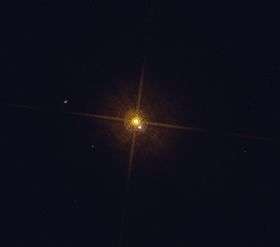W Aquilae
 W Aquilae showing the close companion Credit: Hubble Legacy Archive | |
| Observation data Epoch J2000 Equinox J2000 | |
|---|---|
| Constellation | Aquila |
| Right ascension | 19h 15m 23.347s[1] |
| Declination | 07° 02′ 50.35″[1] |
| Apparent magnitude (V) | (A):7.0 - 14.6[2] (B):14.8[3] |
| Characteristics | |
| A | |
| Spectral type | S6/6e[4] (S3,9e - S6,9e[2]) |
| B−V color index | +2.58[1] |
| Variable type | Mira[2] |
| B | |
| Spectral type | F8/9[4] |
| Astrometry | |
| Radial velocity (Rv) | −18.0[5] km/s |
| Distance | 400[4] pc |
| Absolute magnitude (MV) | (A): −0.7 - 6.9[3] (B):+7.1[3] |
| Details | |
| A | |
| Mass | 1.04 - 3[4] M☉ |
| Radius | 430 - 473[6] R☉ |
| Luminosity | 9,740 - 28,885[3] L☉ |
| Temperature | 2,250 - 3,175[6] K |
| B | |
| Mass | 1.04 - 1.09[4] M☉ |
| Temperature | 5,900 - 6,170[4] K |
| Other designations | |
| Database references | |
| SIMBAD | data |
W Aquilae (W Aql / SAO 143184 / GC 2525) is a variable star in the constellation Aquila. Its distance from the solar system is estimated between 1,100 and 7,502 light-years.
Spectral type S3,9e-S6,9e, W Aquilae is a star of S-type, a red giant similar to those of M-type, but in which the dominant spectrum oxides are formed by metals of the fifth period of the periodic table . W Aquilae is also rich in the element technetium. Another feature of this class of stars is the stellar mass loss, in the case of W Aquilae is estimated at ~ 4 × 10-7 solar masses per year. Its effective temperature is about between 2,250 - 3,175 K and its diameter is between 430 - 473 solar radii. It is also a very bright star, between 9,740 - 28,885 times more than the sun.
W Aquilae is a variable whose brightness oscillates between magnitude +7.3 and +14.3 over a period of 490.43 days.5 In Mira variables whose prototype is Mira – instability comes pulsation in the stellar surface, causing changes in color and brightness. Some of them, among which is W Aquilae show SiO maser emission.
References
- 1 2 3 Høg, E.; Fabricius, C.; Makarov, V. V.; Urban, S.; Corbin, T.; Wycoff, G.; Bastian, U.; Schwekendiek, P.; Wicenec, A. (2000). "The Tycho-2 catalogue of the 2.5 million brightest stars". Astronomy and Astrophysics. 355: L27. Bibcode:2000A&A...355L..27H.
- 1 2 3 Samus, N. N.; Durlevich, O. V.; et al. (2009). "VizieR Online Data Catalog: General Catalogue of Variable Stars (Samus+ 2007-2013)". VizieR On-line Data Catalog: B/gcvs. Originally published in: 2009yCat....102025S. 1. Bibcode:2009yCat....102025S.
- 1 2 3 4 Mayer, A.; Jorissen, A.; Kerschbaum, F.; Ottensamer, R.; Nowotny, W.; Cox, N. L. J.; Aringer, B.; Blommaert, J. A. D. L.; Decin, L.; Van Eck, S.; Gail, H.-P.; Groenewegen, M. A. T.; Kornfeld, K.; Mecina, M.; Posch, Thomas; Vandenbussche, B.; Waelkens, C. (2013). "Large-scale environments of binary AGB stars probed by Herschel. I. Morphology statistics and case studies of R Aquarii and W Aquilae". Astronomy & Astrophysics. 549: A69. arXiv:1211.3595
 . Bibcode:2013A&A...549A..69M. doi:10.1051/0004-6361/201219259.
. Bibcode:2013A&A...549A..69M. doi:10.1051/0004-6361/201219259. - 1 2 3 4 5 6 Danilovich, T.; Olofsson, G.; Black, J. H.; Justtanont, K.; Olofsson, H. (2015). "Classifying the secondary component of the binary star W Aquilae". Astronomy & Astrophysics. 574: A23. arXiv:1501.00863
 . Bibcode:2015A&A...574A..23D. doi:10.1051/0004-6361/201423672.
. Bibcode:2015A&A...574A..23D. doi:10.1051/0004-6361/201423672. - ↑ Wilson, Ralph Elmer (1953). "General catalogue of stellar radial velocities". Washington. Bibcode:1953GCRV..C......0W.
- 1 2 Tevousjan, S.; Abdeli, K.-S.; Weiner, J.; Hale, D. D. S.; Townes, C. H. (2004). "Mid-Infrared Interferometry on Dust Shells around Four Late-Type Stars". The Astrophysical Journal. 611: 466. Bibcode:2004ApJ...611..466T. doi:10.1086/421990.